The rhythm of the heart, the sway of our souls, echoing centuries of history, resilience, and passion. Dive in and see how our movements are an intricate tapestry of ancient stories, interwoven by ancestors who danced to the beat of freedom.
When one thinks of America, freedom often comes to mind. But what about choreographed freedom? Yes, you read that right. Dance, as we know it in America, has been significantly shaped by African influences, a silent yet loud cry of freedom expressed through footwork, jumps, and swirls. How can the human body, restricted by bones and muscles, express limitless freedom? The answer lies within the roots of African dance and its journey to the American stage.
Imagine you're starting your morning, preparing for another day in this LinkedIn-driven corporate world. You put on your favorite tune, and without realizing, your feet start tapping, and your body sways to the beat. That beat, that rhythm, has roots that trace back to African shores where every dance told a story, every step was a message, and every beat was the heartbeat of a community.
Now, the power of dance isn't just to entertain. It’s about unity, resilience, and most of all, freedom. The dances that sprouted from African cultures were not just mere steps; they were narratives of everyday life, celebrations, rites of passage, and much more. Transported across oceans, they merged, evolved, and intertwined with other dance forms in America. Jazz, tap, hip-hop, and even elements of contemporary dance are drenched in African influence. It’s a love letter, a tale of endurance, evolution, and elegance; it's the echoing voice of ancestors in every pop, lock, and drop.
LinkedIn isn’t just about jobs, networking, or corporate achievements; it's about individuals, their stories, and their journeys. And isn’t the tale of African influence on American dance forms a beautiful choreographed tapestry of stories? If these dance forms were to have a LinkedIn profile, it would read “Choreographer: Ancestral Spirits; Endorsed by: Generations of Passionate Dancers; Skills: Storytelling, Expressing Freedom, and Cultural Evolution.”


